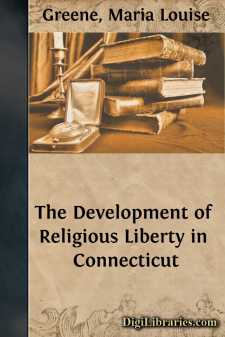Categories
- Antiques & Collectibles 13
- Architecture 36
- Art 48
- Bibles 22
- Biography & Autobiography 813
- Body, Mind & Spirit 142
- Business & Economics 28
- Children's Books 14
- Children's Fiction 11
- Computers 4
- Cooking 94
- Crafts & Hobbies 4
- Drama 346
- Education 46
- Family & Relationships 57
- Fiction 11828
- Games 19
- Gardening 17
- Health & Fitness 34
- History 1377
- House & Home 1
- Humor 147
- Juvenile Fiction 1873
- Juvenile Nonfiction 202
- Language Arts & Disciplines 88
- Law 16
- Literary Collections 686
- Literary Criticism 179
- Mathematics 13
- Medical 41
- Music 40
- Nature 179
- Non-Classifiable 1768
- Performing Arts 7
- Periodicals 1453
- Philosophy 64
- Photography 2
- Poetry 896
- Political Science 203
- Psychology 42
- Reference 154
- Religion 513
- Science 126
- Self-Help 84
- Social Science 81
- Sports & Recreation 34
- Study Aids 3
- Technology & Engineering 59
- Transportation 23
- Travel 463
- True Crime 29
The Development of Religious Liberty in Connecticut
Description:
Excerpt
CHAPTER I
THE EVOLUTION OF EARLY CONGREGATIONALISM
The stone which the builders rejected is become the head of the corner.—Psalm cxviii, 22.
The colonists of Plymouth, Massachusetts, Connecticut, and New Haven were grounded in the system which became known as Congregational, and later as Congregationalism. At the outset they differed not at all in creed, and only in some respects in polity, from the great Puritan body in England, out of which they largely came.[a]
For more than forty years before their migration to New England there had been in old England two clearly developed forms of Congregationalism, Brownism and Barrowism. The term Congregationalism, with its allied forms Congregational and Congregationalist, would not then have been employed. They did not come into general use until the latter half of the seventeenth century, and were at first limited in usage to defining or referring to the modified church system of New England. The term "Independent" was preferred to designate the somewhat similar polity among the nonconformist churches in old England.[b] Brownism and Barrowism are both included in Dr. Dexter's comprehensive definition of Congregationalism, using the term "to designate that system of thought, faith, and practice, which starting with the dictum that the conditions of church life are revealed in the Bible, and are thence to be evolved by reverent common-sense, assisted but never controlled by all other sources of knowledge; interprets that book as teaching the reality and independent competency of the local church, and the duty of fraternity and co-working between such churches; from these two truths symmetrically developing its entire system of principles, privileges, and obligations." [1] The "independent competency of the local church" is directly opposed to any system of episcopal government within the church, and is diametrically opposed to any control by king, prince, or civil government. Yet this was one of the pivotal dogmas of Browne and of the later Separatists; this, a fundamental doctrine which Barrowe strove to incorporate into a new church system, but into one having sufficient control over its local units to make it acceptable to a people who were accustomed to the autonomy and stability of a church both episcopal and national in character.
In order to appreciate the changes in church polity and in the religious temper of the people for which Browne and Barrowe labored, one must survey the field in which they worked and note such preparation as it had received before their advent. It is to be recalled that Henry VIII substituted for submission to the Pope submission to himself as head of a church essentially Romish in ritual, teaching, and authority over his subjects. The religious reformation, as such, came later and by slow evolution through the gradual awakening of the moral and spiritual perceptions of the masses. It came very slowly notwithstanding the fact that the first definite and systematic opposition to the abuses and assumptions of the clergy had arisen long before Henry's reign....


